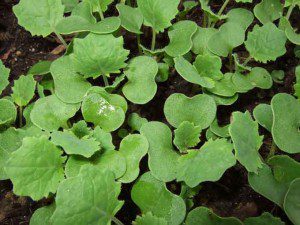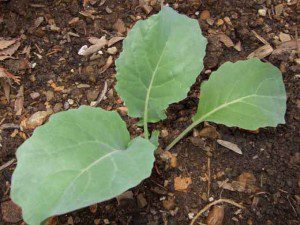Answer: The second that you decide not to label the growing seedlings! While I hate to stick labels and tags in my vegetable garden, sometimes it really is the easiest way to avoid confusion when the seedlings poke their heads up from the ground.
Jasmeen is finding this out the hard way as the following inquiry details…
“Hi Kenny, this is the first year I’m planting a vegetable garden. With no experience, I made a lot of mistakes. The big question I have right now is how do I identify cauliflowers and collard greens?”
“I planted kale, collards and cauliflowers in the same plot, didn’t label them thinking “oh, they’ll grow up to be different and I can separate them”. So far, the cauliflower doesn’t have its head or floret. And they all look the same. What should I look for to distinguish them?” – Jasmeen
It’s Times Like These When it Really Does Pay to Label Your Plants
 There’s nothing more unnatural than a plastic plant labels protruding from the earth and many veteran gardeners take pride in their ability to identify their babies from the very first leaf, but that skill only comes through experience and close observation.
There’s nothing more unnatural than a plastic plant labels protruding from the earth and many veteran gardeners take pride in their ability to identify their babies from the very first leaf, but that skill only comes through experience and close observation.
Even a master gardener will find it challenging to distinguish between different varieties of the same plant, or vegetables that they have never grown before. As humiliating and impersonal as it may seem to use labels, it’s better to play it safe than sorry when it comes to identifying your young seedlings.
Some times identity isn’t as important and you can sort things out as the plants mature and give away their true identities. But on other occasions it’s important to know exactly what plant you’re dealing with for the purposes of spacing, thinning, and planning production and harvest yields.
Nobody wants to plant a few heads of cabbage and lots of kale and collards, only to wind up with more cabbages than they could possibly eat and a supply of leafy greens that don’t amount to a much due to a case of mistaken identity!
Calling Out All the Masquerading Collard Plants
 Most vegetables in the Brassica family, which include; kale, collards, Brussels Sprouts, broccoli, cauliflower, cabbage, kohl rabi, mustard, and turnips have leaves that look very similar during their seedling stages and sometimes even beyond.
Most vegetables in the Brassica family, which include; kale, collards, Brussels Sprouts, broccoli, cauliflower, cabbage, kohl rabi, mustard, and turnips have leaves that look very similar during their seedling stages and sometimes even beyond.
There are slight differences that are difficult to describe, but observation and experience will be your best bets for telling the plants apart. In general collard leaves tend to take on a more rounded shape and the plants develop larger leaves as the plants grow in comparison to cauliflower.
The older any plants become, the more evident the tell tale differences will become to distinguish between related crops. Studying those details is the surest way to develop an eye for identifying various plant species, varieties, and even common weeds from the earliest stages of their development.
Leaf shape is usually the biggest give away, but you can also get important clues to a plant’s identity from its size, growth habits, and those subtle variations in color. The more dirt time you spend observing your plants as they grow, the easier it will become for you to tell them apart, regardless of their maturity.
Good luck at discerning the differences between your collards and cauliflower; you’ll probably be much better at that skill this time next season. For now I hope that your family enjoys eating lots of collard greens… or should I say cauliflowers?



 Address:
Address: EMAIL:
EMAIL: Telephone:
Telephone: